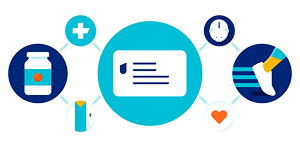If you aren’t familiar with what basic health insurance terms mean, you might end up with a plan that’s not right for you, pay more than you expected, or find out that certain services aren’t covered — or all the above.
Here are 9 terms that you’ll want to know when shopping for health insurance.
Need a health insurance plan for you or your family? Explore your options now, or contact a licensed insurance agent at 1-844-211-7730.
Health insurance term #1: Deductible
A deductible is the amount you owe for covered health care services before your health insurance or plan will start paying each plan year. For example, if your deductible is $1,000, your plan won’t pay for covered expenses until you’ve met it — or until you’ve paid that amount yourself in covered medical expenses.
Health insurance term #2: Copayment (or copay)
This is the fixed amount you pay for a covered health care service, such as a doctor visit. The amount can vary by the type of covered health service — for example, a copay for a specialist may be more than a copay you’d pay to be seen by your primary care provider.
Health insurance term #3: Coinsurance
This is the portion of the medical cost that you pay for covered expenses after your deductible has been met. It’s your share of a covered health care service, calculated as a percentage.
For example, you may need to pay 20% of a medical expense — and your insurance pays the rest. “If you want to pay a lower premium, you’ll need to a pay a higher coinsurance,” explains Adria Gross, a health insurance advocate and CEO and founder of MedWise Insurance Advocacy and MedWise Billing. (A premium is your monthly insurance bill; learn more below.)
It can vary from as much as a 50/50 split (you and your insurance each pay half) to as little as 5% coinsurance, meaning the insurance company pays 95% of the cost. “The lower the coinsurance, the higher the deductible and premium,” Gross notes.
Health insurance term #4: Premium
A premium is the monthly amount that you or your employer pays for your health insurance plan. “Usually, the higher the premium, the lower the deductible, as well as the lower the coinsurance and copays,” says Gross. “The lower the premium, the higher the deductible, copays and coinsurance.”
Your monthly insurance bill may change each year.
Looking for a great way to get health insurance for you or your family? Enter your ZIP code to search available plans, or call a licensed insurance agent at 1-844-211-7730.
Health insurance term #5: Prior authorization
You might see prior authorization referred to as either “preauthorization” and “precertification.” This is a decision by your health insurance company about:
- Health care services
- Medical equipment (such as crutches or a wheelchair)
- Prescription drugs
- Treatment plans
You may need to get the approval in advance, or it might not be covered. (Having prior authorization is still not a guarantee that your insurer will pay for it.) Your plan may require this for certain services, except when it’s an emergency.
It also depends on the services you’re getting, she says. For example, a more serious procedure, such as surgery, is more likely to require prior authorization.
If your insurance requires this, make sure that your medical provider’s office requests it before you have the procedure and that it is considered a covered benefit. That makes it less likely that a claim will be denied. If that were to happen, you might have to shoulder a big insurance bill.
Ready to explore insurance plans where you live?
Health insurance term #6: In network
A network includes the facilities, providers and suppliers your health insurance company has contracted with to provide health care services. Once you’ve met your deductible, you have to pay a fixed amount of a copay or a fixed percentage of coinsurance to these providers. These costs are usually less when you’re in network, meaning when you use those specific facilities, providers and suppliers. Things can get more expensive when you go out of network (see immediately below).
Health insurance term #7: Out of network
An out-of-network provider is one who doesn’t have a contract with your health insurer to provide services to you. You’ll usually pay more out of your own pocket with one of these providers, and sometimes your insurance won’t cover it.
“Policies that are an HMO (health maintenance organization) and sometimes an EPO (exclusive provider organization) usually will not [pay for] out-of-network providers unless you prove there are no in-network providers in your area or if only very limited providers can provide the services you may require,” explains Gross.
But if you have a preferred provider organization, or PPO, you can usually go out of network. Your deductible, copays and coinsurance will be higher. For example, you may pay 40% coinsurance if you go out of network, compared with 20% coinsurance in the network.
Health insurance term #8: Balance billing
This is when a doctor’s office bills you the difference between what they charge for a procedure and what the insurance says is the allowed amount. For example, that might happen if a doctor charges you $100 for a visit but the allowed amount is $70. If the doctor is in network, they are not allowed to bill you for the remaining $30. But if they are out of network, they can require you to pay the difference.
Health insurance term #9: Maximum out-of-pocket limit
This is the most you will pay out of pocket during your health insurance’s plan period (usually a year) before your health insurance or plan begins to pay 100% of the allowed amount. This limit doesn’t include:
- Balance billing (see above)
- Health care your health insurance plan doesn’t cover
- Your monthly insurance bill
Always read your policy carefully: Some health insurance plans don’t count copays, deductibles, coinsurance or out-of-network payments toward this limit. Each plan has an out-of-pocket limit for an individual and a different one for a family, adds Gross. Keep in mind that the higher your monthly insurance bill, the lower your maximum out-of-pocket limit usually is.
Now that you have a better idea of what some of the key health insurance terms mean, it’s time to start shopping. Wondering which health insurance plan is right for you? Get more details, or call a licensed agent at 1-844-211-7730.
Compliance code:
50402-X-1123











